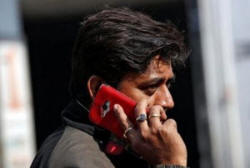|
China nibbles at Samsung
share to take 50 percent of India's smartphone market
 Send a link to a friend
Send a link to a friend
 [January 06, 2017]
By Sankalp Phartiyal [January 06, 2017]
By Sankalp Phartiyal
MUMBAI
(Reuters) - Chinese brands took their largest ever slice of the
$10-billion Indian smartphone market in late 2016, accounting for more
than one in every two phones sold - a growing market share that ate into
sales from top-selling Samsung Electronics.
Samsung, the single most popular smartphone brand in India, commanded a
roughly 30 percent market share just over a year ago. That slipped to 21
percent in November, according to tech research firm Counterpoint, the
last month for which data is available.
Meanwhile - thanks to low cost, improved technology and an advertising
blitz - Chinese brands like Oppo, Lenovo, OnePlus, Gionee and Xiaomi
took a combined share of over 50 percent, compared to just 19 percent a
year ago.
"Chinese brands are offering quality that is at par with Samsung, at a
better price," said Manish Khatri, who owns two multi-brand smartphone
outlets in Mumbai. "Of every 10 phones I sell, almost six to seven are
now Chinese brands."

Celebrity endorsements from Bollywood actors like Hrithik Roshan and
Ranveer Singh, along with huge sponsorship campaigns by brands such as
Oppo and Gionee of the wildly popular Indian Premier League cricket
franchise have helped improve perception of Chinese brands - once
derided for their low quality.
"In a country like India, there are two religions - one is Bollywood and
the second is cricket," said Arvind R Vohra, Gionee's India head, noting
that both avenues have helped popularize its brand.
Chinese brand executives said innovative product features such as
powerful selfie cameras with flash, quicker charging and longer-lasting
batteries have also helped them thrive in India, one of the world's
biggest and fastest growing smartphone markets.
In the large and ultra-competitive $120 to $440 mid-market smartphone
segment, Chinese vendors have more than doubled their market share to 68
percent, while Samsung has lost 14 percentage points since November
2015, according to Counterpoint.
[to top of second column] |

A man talks on his mobile phone while walking on a road in Kolkata,
India January 6, 2017. REUTERS/Rupak De Chowdhuri

"Being
a global company is Samsung's biggest curse," says Neil Shah of Counterpoint,
adding Samsung cannot compete on price like their Chinese rivals, who are
focused more on low-cost markets like China, India and Indonesia.
Shah said Chinese vendors' access to low-cost components and their expertise in
designing metal casing for cheap phones has let brands like Oppo, OnePlus and
Lenovo offer better quality products than Samsung, which uses plastic for its
cheapest models.
Adding
to Samsung's woes last year was the arrival of billionaire Mukesh Ambani's new
telecom venture Jio, with heavily subsidised handsets to get customers on its 4G
network.
Dyaneshwar Sarde, a 33-year-old Indian farmer who earlier used a Samsung device,
said he wanted to buy a 4G smartphone to use Reliance Jio.
"Samsung phones were comparatively expensive, so I ended up buying a Lenovo a
friend recommended."
India's home-grown brands such as Micromax, Lava and Karbonn are feeling the
heat even more, according to Counterpoint, with their total market share having
dropped to less than 20 percent from over 40 percent last year.
(Reporting by Sankalp Phartiyal; Editing by Clara Ferreira-Marques and Randy
Fabi)
[© 2017 Thomson Reuters. All rights
reserved.] Copyright 2017 Reuters. All rights reserved. This material may not be published,
broadcast, rewritten or redistributed.
 |